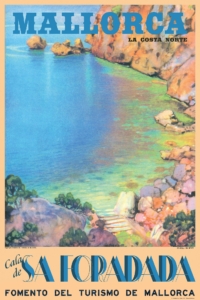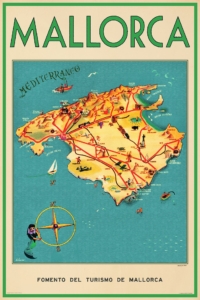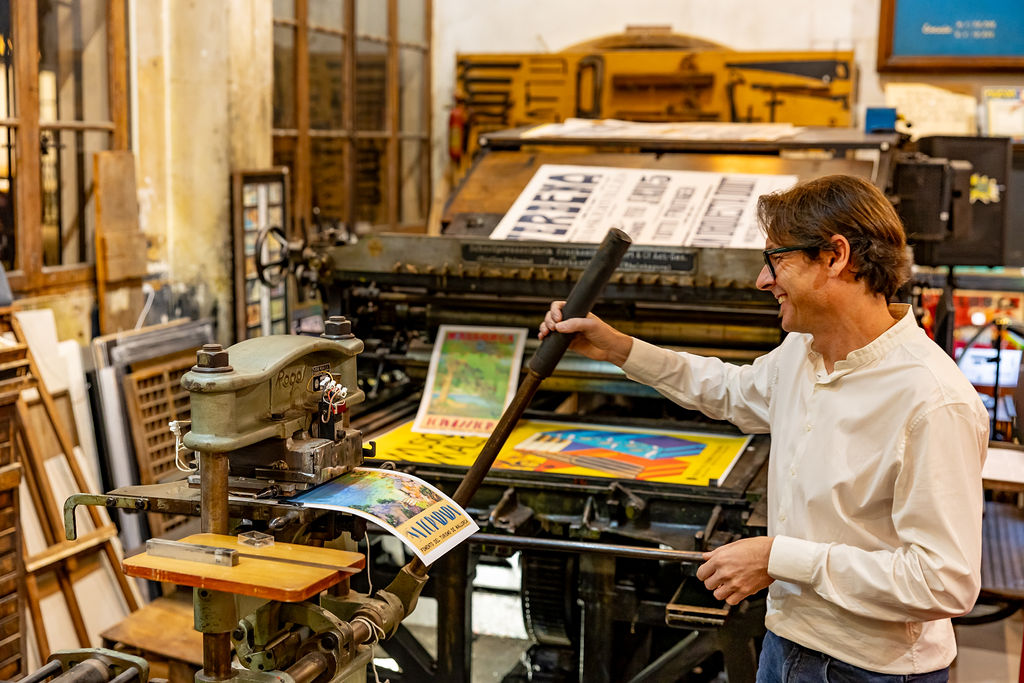The Mallorca Tourist Board (The Fomento del Turismo de Mallorca) and Stick No BillsⓇ Global Poster Gallery at Nueva Balear Printworks present three new vintage posters based on images from the 1930s and 1950s.
Stick No BillsⓇ Global Poster Gallery at Nueva Balear Printworks (the oldest printworks on the island) and the Mallorca Tourist Board have launched new vintage posters featuring images from the 1930s and 1940s, as part of the Mallorca Vintage® collection. The goal of this collection is to highlight Mallorca’s rich natural, cultural, and touristic heritage, showcasing iconic locations like Cala Deià and Sa Foradada, painted in the 1930s by Austrian artist Erwin Hubert. A third addition is a map of Mallorca, originally distributed to tourists arriving on the island in the 1950s.
Historic Posters Celebrating Mallorca’s Natural Beauty
The Mallorca Tourist Board and Stick No BillsⓇ —specialists in vintage-inspired modern graphic art—launched the Mallorca VintageⓇcollection in 2020 after uncovering authentic gems in the Tourist Board’s extensive archives, such as old promotional posters. The collection now includes 21 designs, with three new additions officially launched this month from 25 pounds sterling for an open-edition A3 size poster: https://sticknobillsonline.com/collections/fomento-del-turismo
A Tribute to Philip James Baber’s Vision
The Fomento pays tribute to co-founder of Stick No BillsⓇ, Philip James Baber, for bringing the collection to life. Thanks to him he breathed new life into the Tourist Board’s original images from the earliest tourism campaigns that tell the story of tourism in Mallorca.
New Images of Iconic Mallorcan Landscapes
 Two of the newly added images are remastered versions by Stick No BillsⓇ of original watercolors of Cala Deià and Sa Foradada by Erwin Hubert from the 1930s. The third addition is a map of Mallorca first published in a promotional brochure in the 1950s.
Two of the newly added images are remastered versions by Stick No BillsⓇ of original watercolors of Cala Deià and Sa Foradada by Erwin Hubert from the 1930s. The third addition is a map of Mallorca first published in a promotional brochure in the 1950s.
These images, drawn from the Tourist Board archives and remastered by Stick No BillsⓇ, are now available in various paper qualities and sizes at the Nueva Balear Global Poster Gallery in Palma and online at sticknobillsonline.com.
Cala Deià and Sa Foradada – 1930s
 Hubert extensively painted the coastline known as “Costa Nord.” His watercolor of Cala Deià captures the rugged beauty of that seaside landscape, with a view over the cove that has inspired many artists over the years and continues to do so. The second image features Sa Foradada, one of the island’s most impressive viewpoints, located on the northwest coast between Cala Deià and Caló d’Estaca. It is one of the best-known landmarks along this coast, with its distinctive rock formation rising from the sea with a hole at the top “foradada” means “pierced” in Catalan. This watercolor by Hubert shows the steps leading down to the rocky coastline where people can swim.
Hubert extensively painted the coastline known as “Costa Nord.” His watercolor of Cala Deià captures the rugged beauty of that seaside landscape, with a view over the cove that has inspired many artists over the years and continues to do so. The second image features Sa Foradada, one of the island’s most impressive viewpoints, located on the northwest coast between Cala Deià and Caló d’Estaca. It is one of the best-known landmarks along this coast, with its distinctive rock formation rising from the sea with a hole at the top “foradada” means “pierced” in Catalan. This watercolor by Hubert shows the steps leading down to the rocky coastline where people can swim.
Map of Mallorca – circa 1950
 This map was first reproduced for a visitor brochure in the 1950s. The colorful, “naïve” illustration by artist Hilario features a Mallorquin mermaid holding a compass in the foreground, a charming reproduction of the Mallorca Tourist Board’s oldest promotional material.
This map was first reproduced for a visitor brochure in the 1950s. The colorful, “naïve” illustration by artist Hilario features a Mallorquin mermaid holding a compass in the foreground, a charming reproduction of the Mallorca Tourist Board’s oldest promotional material.
Promoting Responsible Global Tourism
For the Mallorca Tourist Board, reissuing these posters serves a dual purpose: firstly, sales through Stick No BillsⓇ Global Poster Gallery at Nueva Balear provide a new source of revenue for the century-old, non-profit institution. The Tourist Board, funded by memberships from companies and individuals, promotes responsible, respectful, and quality tourism, for example, through its International Press Centre.
Furthermore, the worldwide distribution of these vintage images of Mallorca helps promote this type of tourism on a global scale. Since online sales began, nearly 54,000 posters have been sold in almost 20 countries, with the United Kingdom, Germany, and the United States as primary markets, as well as countries such as Saudi Arabia, New Zealand, Canada, and Côte d’Ivoire.
About Erwin Hubert
Mallorca became the adopted home of Austrian artist Erwin Hubert (1883–1963). He initially moved to Palma to serve as secretary to Archduke Ludwig Salvator of Austria. With the outbreak of war in 1914, he returned to Vienna, but in 1920 he came back to Mallorca, where he spent the rest of his life, becoming a prominent ambassador of the island through his paintings.
His charming watercolors, painted throughout the 1930s, depict idyllic natural landscapes and were acquired by the Mallorca Tourist Board to be used on posters, postcards, and promotional brochures across Europe. It is said that Hubert’s 1930s paintings helped shape Mallorca’s postwar image as a paradise island of great beauty, peace, and tranquility. The first editions of each of these images were printed by the Mallorca Tourist Board around 1949.

